Abstract
An experiment was conducted to determine the extent that NO3− taken up in the dark was assimilated and utilized differently by plants than NO3− taken up in the light. Vegetative, nonnodulated soybean plants (Glycine max L. Merrill, `Ransom') were exposed to 15NO3− throughout light (9 hours) or dark (15 hours) phases of the photoperiod and then returned to solutions containing 14NO3−, with plants sampled subsequently at each light/dark transition over 3 days. The rates of 15NO3− absorption were nearly equal in the light and dark (8.42 and 7.93 micromoles per hour, respectively); however, the whole-plant rate of 15NO3− reduction during the dark uptake period (2.58 micromoles per hour) was 46% of that in the light (5.63 micromoles per hour). The lower rate of reduction in the dark was associated with both substantial retention of absorbed 15NO3− in roots and decreased efficiency of reduction of 15NO3− in the shoot. The rate of incorporation of 15N into the insoluble reduced-N fraction of roots in darkness (1.10 micromoles per hour) was somewhat greater than that in the light (0.92 micromoles per hour), despite the lower rate of whole-plant 15NO3− reduction in darkness.
A large portion of the 15NO3− retained in the root in darkness was translocated and incorporated into insoluble reduced-N in the shoot in the following light period, at a rate which was similar to the rate of whole-plant reduction of 15NO3− acquired during the light period. Taking into account reduction of NO3− from all endogenous pools, it was apparent that plant reduction in a given light period (∼13.21 micromoles per hour) exceeded considerably the rate of acquisition of exogenous NO3− (8.42 micromoles per hour) during that period. The primary source of substrate for NO3− reduction in the dark was exogenous NO3− being concurrently absorbed. In general, these data support the view that a relatively small portion (<20%) of the whole-plant reduction of NO3− in the light occurred in the root system.
Full text
PDF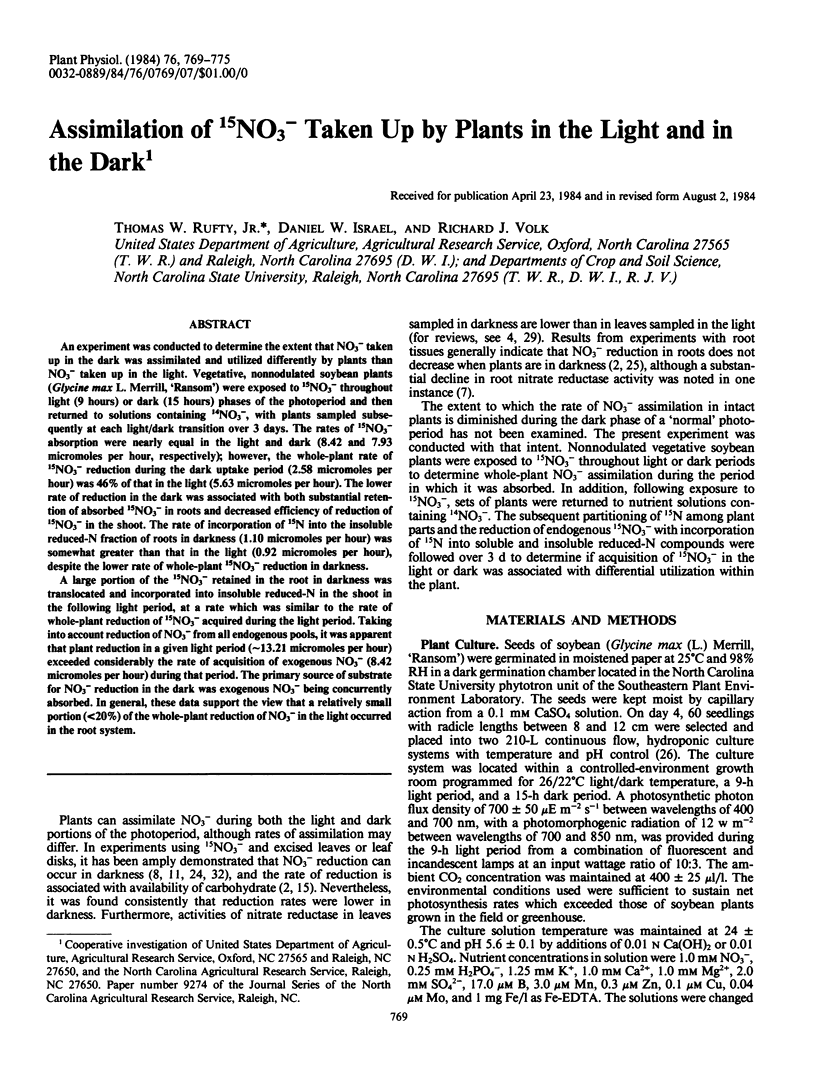
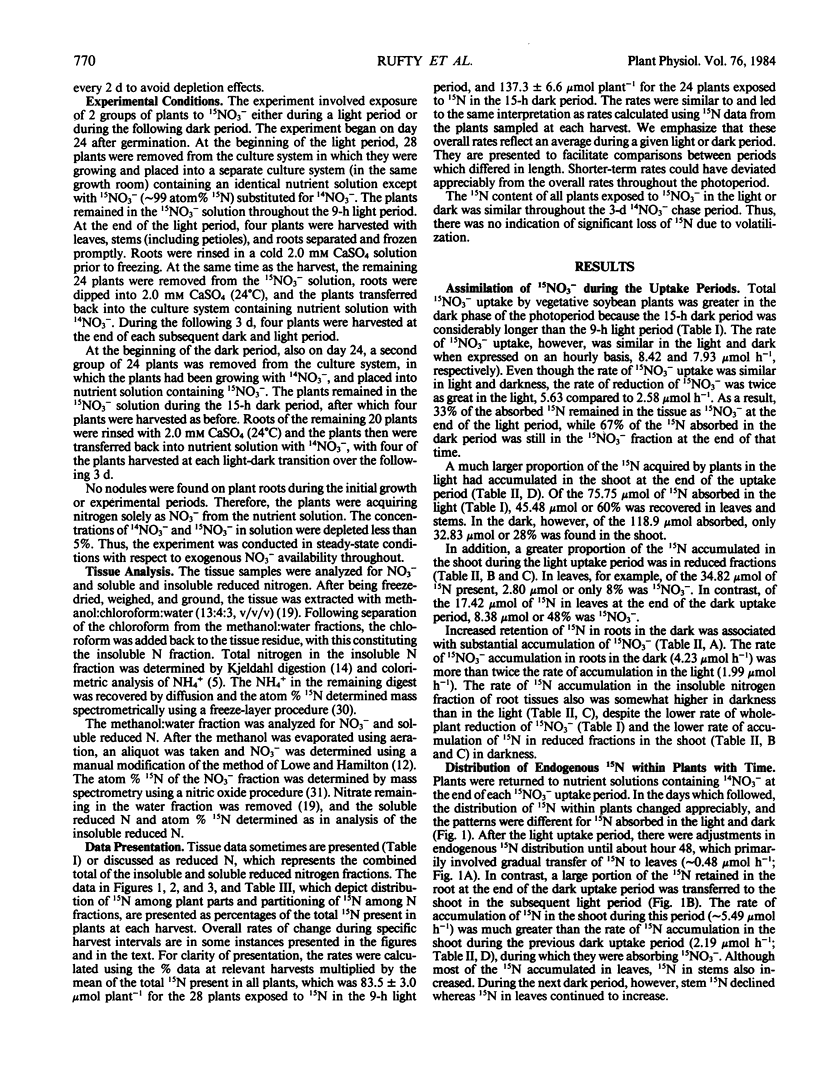
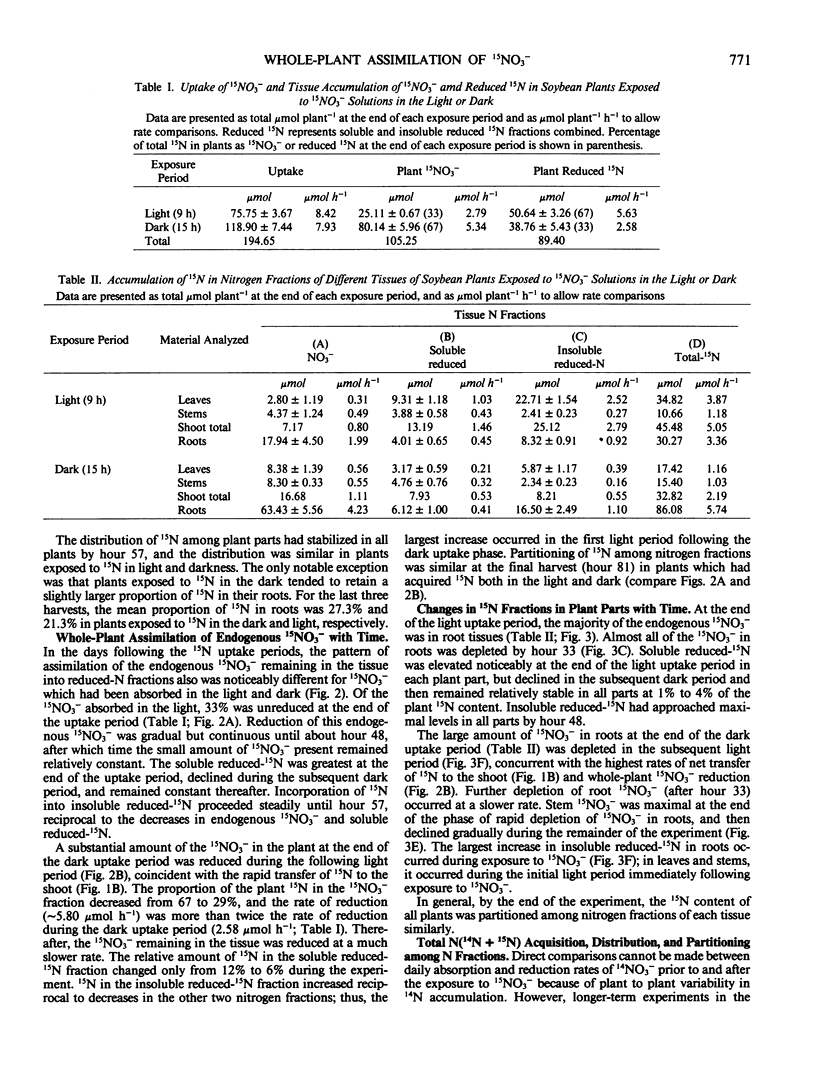
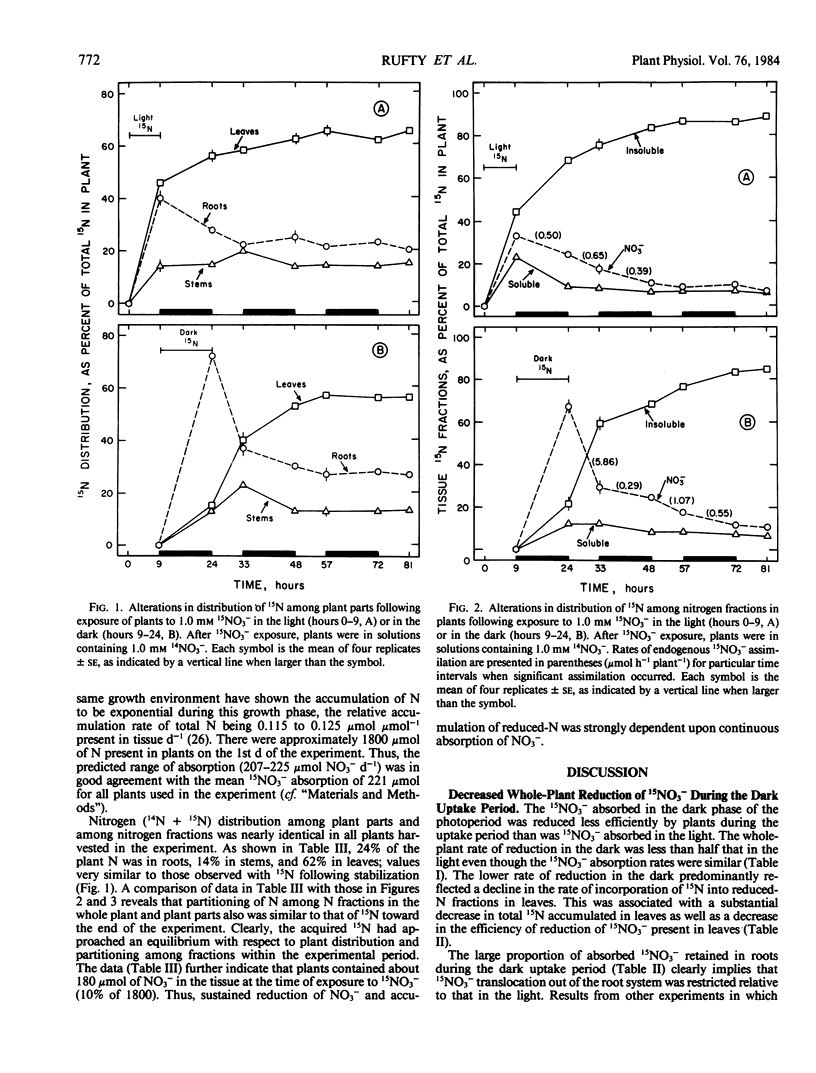
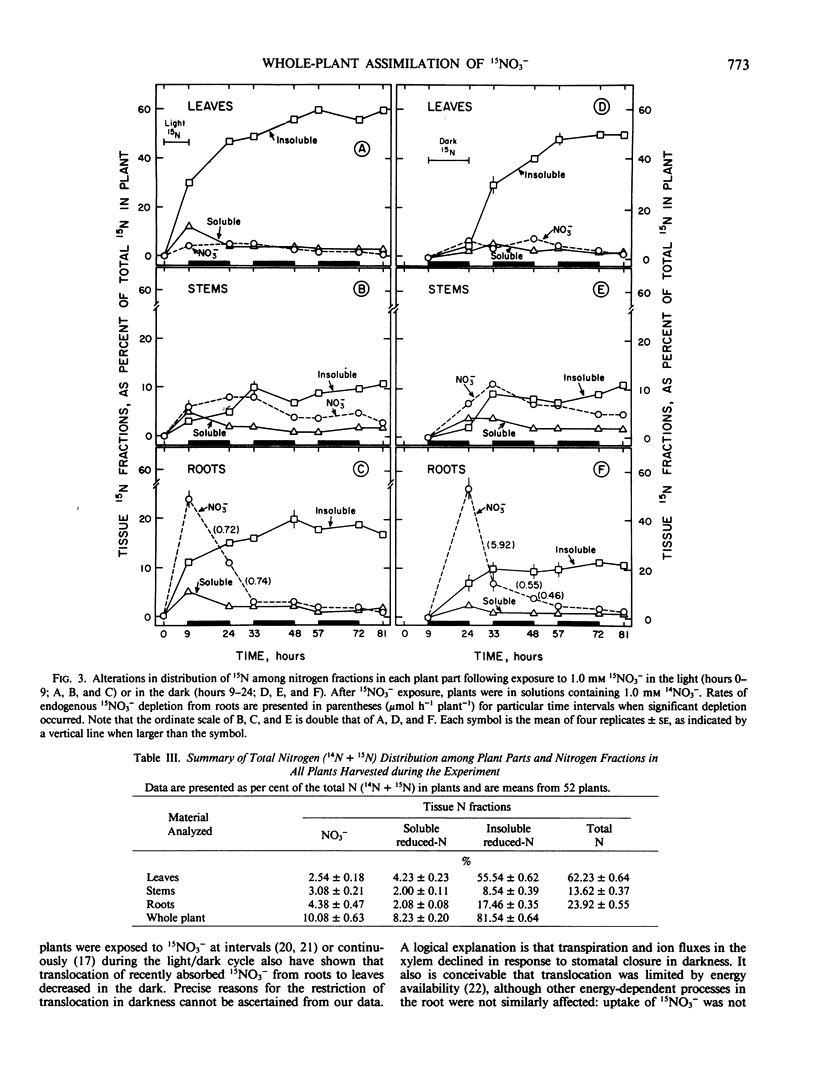
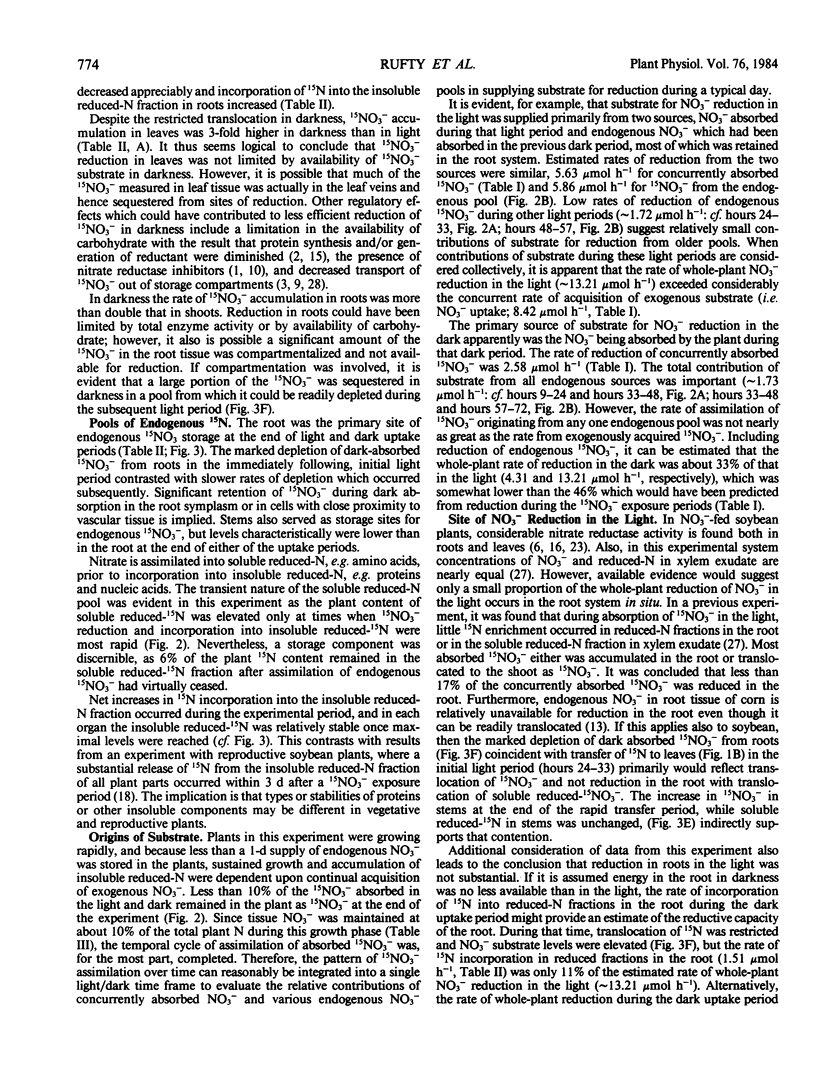
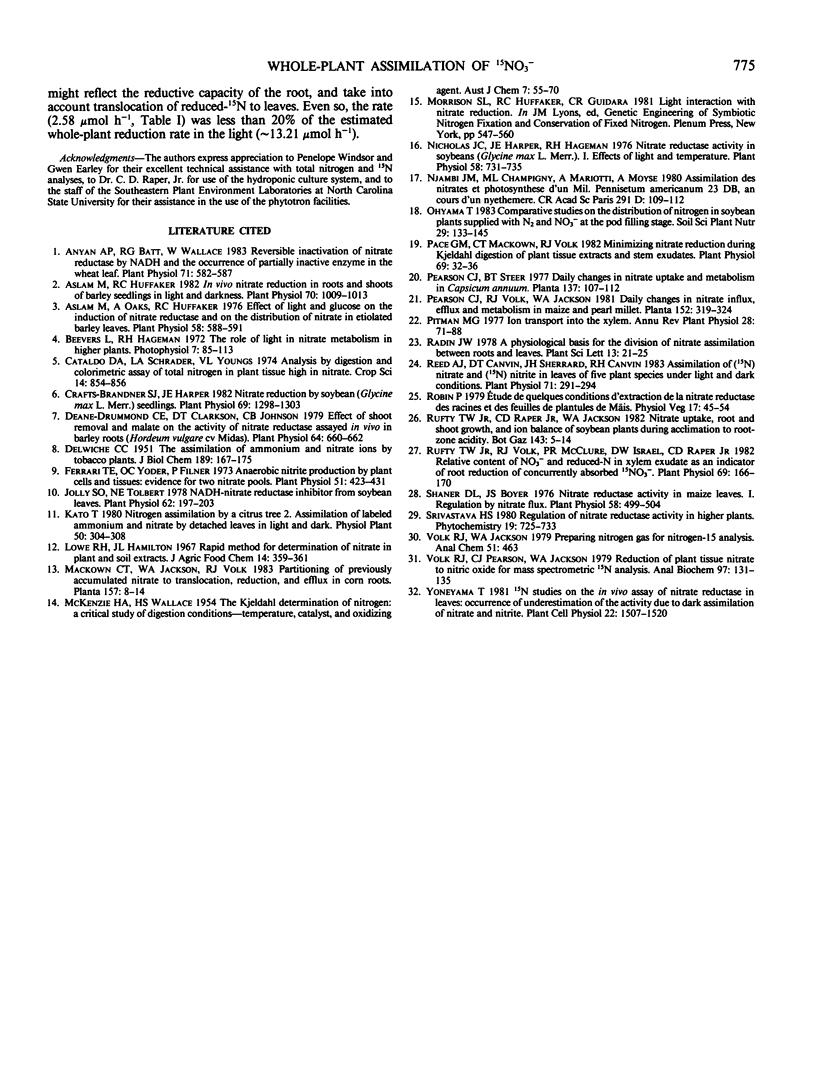
Selected References
These references are in PubMed. This may not be the complete list of references from this article.
- Aryan A. P., Batt R. G., Wallace W. Reversible Inactivation of Nitrate Reductase by NADH and the Occurrence of Partially Inactive Enzyme in the Wheat Leaf. Plant Physiol. 1983 Mar;71(3):582–587. doi: 10.1104/pp.71.3.582. [DOI] [PMC free article] [PubMed] [Google Scholar]
- Aslam M., Huffaker R. C. In Vivo Nitrate Reduction in Roots and Shoots of Barley (Hordeum vulgare L.) Seedlings in Light and Darkness. Plant Physiol. 1982 Oct;70(4):1009–1013. doi: 10.1104/pp.70.4.1009. [DOI] [PMC free article] [PubMed] [Google Scholar]
- Aslam M., Oaks A., Huffaker R. C. Effect of light and glucose on the induction of nitrate reductase and on the distribution of nitrate in etiolated barley leaves. Plant Physiol. 1976 Oct;58(4):588–591. doi: 10.1104/pp.58.4.588. [DOI] [PMC free article] [PubMed] [Google Scholar]
- Beevers L., Hageman R. H. The role of light in nitrate metabolism in higher plants. Photophysiology. 1972;(7):85–113. [PubMed] [Google Scholar]
- Crafts-Brandner S. J., Harper J. E. Nitrate Reduction by Roots of Soybean (Glycine max [L.] Merr.) Seedlings. Plant Physiol. 1982 Jun;69(6):1298–1303. doi: 10.1104/pp.69.6.1298. [DOI] [PMC free article] [PubMed] [Google Scholar]
- DELWICHE C. C. The assimilation of ammonium and nitrate ions by tobacco plants. J Biol Chem. 1951 Mar;189(1):167–175. [PubMed] [Google Scholar]
- Deane-Drummond C. E., Clarkson D. T. Effect of Shoot Removal and Malate on the Activity of Nitrate Reductase Assayed in Vivo in Barley Roots (Hordeum vulgare cv. Midas). Plant Physiol. 1979 Oct;64(4):660–662. doi: 10.1104/pp.64.4.660. [DOI] [PMC free article] [PubMed] [Google Scholar]
- Ferrari T. E., Yoder O. C., Filner P. Anaerobic nitrite production by plant cells and tissues: evidence for two nitrate pools. Plant Physiol. 1973 Mar;51(3):423–431. doi: 10.1104/pp.51.3.423. [DOI] [PMC free article] [PubMed] [Google Scholar]
- Jolly S. O., Tolbert N. E. NADH-Nitrate Reductase Inhibitor from Soybean Leaves. Plant Physiol. 1978 Aug;62(2):197–203. doi: 10.1104/pp.62.2.197. [DOI] [PMC free article] [PubMed] [Google Scholar]
- Nicholas J. C., Harper J. E., Hageman R. H. Nitrate Reductase Activity in Soybeans (Glycine max [L.] Merr.): I. Effects of Light and Temperature. Plant Physiol. 1976 Dec;58(6):731–735. doi: 10.1104/pp.58.6.731. [DOI] [PMC free article] [PubMed] [Google Scholar]
- Pace G. M., Mackown C. T., Volk R. J. Minimizing Nitrate Reduction during Kjeldahl Digestion of Plant Tissue Extracts and Stem Exudates : APPLICATION TO N STUDIES. Plant Physiol. 1982 Jan;69(1):32–36. doi: 10.1104/pp.69.1.32. [DOI] [PMC free article] [PubMed] [Google Scholar]
- Reed A. J., Canvin D. T., Sherrard J. H., Hageman R. H. Assimilation of [N]Nitrate and [N]Nitrite in Leaves of Five Plant Species under Light and Dark Conditions. Plant Physiol. 1983 Feb;71(2):291–294. doi: 10.1104/pp.71.2.291. [DOI] [PMC free article] [PubMed] [Google Scholar]
- Rufty T. W., Volk R. J., McClure P. R., Israel D. W., Raper C. D. Relative Content of NO(3) and Reduced N in Xylem Exudate as an Indicator of Root Reduction of Concurrently Absorbed NO(3). Plant Physiol. 1982 Jan;69(1):166–170. doi: 10.1104/pp.69.1.166. [DOI] [PMC free article] [PubMed] [Google Scholar]
- Shaner D. L., Boyer J. S. Nitrate Reductase Activity in Maize (Zea mays L.) Leaves: I. Regulation by Nitrate Flux. Plant Physiol. 1976 Oct;58(4):499–504. doi: 10.1104/pp.58.4.499. [DOI] [PMC free article] [PubMed] [Google Scholar]
- Volk R. J., Pearson C. J., Jackson W. A. Reduction of plant tissue nitrate to nitric oxide for mass spectrometric 15N analysis. Anal Biochem. 1979 Aug;97(1):131–135. doi: 10.1016/0003-2697(79)90336-1. [DOI] [PubMed] [Google Scholar]


